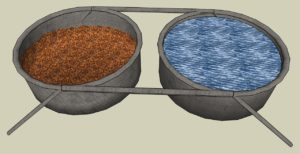
Selecting the Best Dog Diet:
Gluten Free, Raw, and Other Healthy Diets
Just as we search to put good foods into our bodies, our dogs need healthy foods too. Many dog food companies claim to have all the essentials for a healthy life. However, brand-name foods are not always the best choice. A dog’s diet should consist of a healthy balance of protein, fats, carbohydrates, vitamins, and minerals. When these ingredients are not given in balance, a dog can suffer (obesity, bladder stones, and heart disease to name a few ways). When your dog receives the right nutrition, the results are noticeable. Your dog will be more energetic, have a shinier coat, stronger muscles, have increased immunity to diseases, and so much more! Give your best friend the diet she deserves.
Here are some healthy dog diets and the benefits of each:
Gluten Free Dog Diet

If your dog struggles with joint pain, a gluten free diet may be ideal to help alleviate these symptoms. The grains commonly found in dog foods contain gluten, which can cause problems such as diarrhea, allergy symptoms, and also discomfort, both long and short term. It is found that gluten can act as a pro-inflammatory, which can increase joint pain. Reducing or even cutting out gluten can improve your dog’s health and his quality of life. A study done by Dr. John Symes found that gluten acted like glue in the intestine. Once the dogs in the study changed over to the gluten-free diet, their health improved dramatically and quickly. Although not all dogs have a gluten intolerance, eliminating gluten from the diet could still be beneficial. A number of dog food brands offer a gluten-free food line (ex. Blue Freedom, Natural Balance, Instinct). Speak with your vet to discuss the benefits of each brand and be sure to read labels closely when purchasing new food.
Raw Food Dog Diet

The raw food diet has caused much debate over the years. The dog diet is one that includes raw meat, bones, vegetables, and fruits – natural foods that a dog would eat in the wild. The reasoning behind this diet is that the dog is eating what evolution has shown they used to eat before becoming domesticated pets. Because the products in this diet are natural, there is a lower risk of malnutrition from a lack of nutrients, digestive issues, or other problems commonly seen with lower quality dog food. Owners who treat their dogs to the raw food diet have noticed increased energy levels, healthier skin and coat, cleaner teeth, and smaller stools. A few foods that are commonly included in this diet are:
- Apples
- Broccoli
- Raw Eggs
- Liver
- Muscle Meat
BONUS TIP: If you have decided to give your dog the raw food diet, be sure you make the diet balanced. A mistake many owners make is not giving her enough or too much of specific vitamins, minerals, fatty acids, or proteins. Speak with your vet to ensure you plan out a well-balanced diet for your dog so she gets everything that she needs for a nutritious life. There are also a number of meal plans online for raw dog food diets, but it is still wise to have it double-checked by your vet.
Other Healthy Dog Diet Options

Depending on your dog’s eating habits and health, dry food or wet food may be a better option.
Packaged/Dry Foods
Some packaged dry food options lack the proper amount of nutrients, and others can provide too much. With packaged dry food, read the ingredients in each bag. Although dry packaged dog food is convenient and often cost effective, they often include lower quality meats in addition to a higher concentration of grain to cut costs. Another factor to consider is that there is no moisture in the food, so your dog is not getting any water from the source. This requires your dog to drink more water throughout the day. If your dog does not drink enough water on his own, canned wet food is a better choice. On the other hand, dry food has a long shelf life and works great as training treats, and can even improve your dog’s oral health. Gluten free packaged dry foods are available, as well as foods that remove certain ingredients (ingredients that may not be tolerated well with some breeds). Speaking with your vet will help you better understand what ingredients your dog should avoid and what specifications you should keep in mind when purchasing the food.
Canned/Wet Foods
For those who opt for canned foods, there are certain things to be aware of. It is known that canned food is a better option than bagged food for dogs who are not as well hydrated. Wet foods can be beneficial specifically for older dogs that have a harder time chewing the hard kibbles found in dry food. Wet food is also a great alternative for dogs suffering from illness or digestive problems. The extra hydration can get things moving in her body and isn’t as harsh on her stomach as dry food. When using wet food, it is important to know that once a can is opened it can spoil if not stored properly – keep it sealed and in the refrigerator after opened. Always speak with your vet to ensure your dog will receive enough nutrients to keep her in good health.
Each dog is different and not all diets are healthy for all breeds. Work with your vet to adjust each diet for your dog specifically. Just because a dog food brand says it is “best in the business for a dog’s health,” does not mean that it is good enough for YOUR dog’s health. Giving him the right food will increase his well-being and quality of life – and oftentimes even his lifespan.
